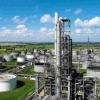Hello,
There has been a case on design conditions of BFW and Steam line.
Boiler Feed Water (BFW), through control valve, enters desuperheater to produce saturated MP Steam. The design conditions of these lines are as follows.
BFW line upto desuperheater flange: 16 barg @ 148 deg C
MP Steam line including upstream & downstream of desuperheater : 12.5 barg @ 240 deg C
There was a concern about overpressurization of MP steam line due to BFW valve full open or blockage of valve in the downstream of desuperheater. But neither PSV was provided in downstream of desuperheater nor the design pressure was increased for MP steam line. This was explained as follows based on ASME.
For "piping components", ASME allows "short-term" increase in pressure during operation up to its test pressure.
(In above case, test pressure of MP steam line was higher than design pressure of BFW line).
Is it true? Can anyone help me to know the reference for this from ASME.
How do I consider increase in pressure as "short term"? Is there any guide by ASME or any other standard to estimate "short term" quantitatively? (e.g. increase in pressure at different time intervals but not exceeding 100 hrs. in total in one year)
Thank you,
|
|

Overpressure Above Design Value
Started by Nirav, Nov 15 2006 03:24 AM
5 replies to this topic
Share this topic:
#1

Posted 15 November 2006 - 03:24 AM
#2

Posted 15 November 2006 - 08:30 AM
Check which ASME code is applicable for your system. Following is from ASME B31.3
(d) The total number of pressure temperature variations above the design conditions shall not exceed 1000 during the life of the piping system.
(e) In no case shall the increased pressure exceed the test pressure used under para. 345 for the piping system.
(f) Occasional variations above the design conditions remain within one of the following limits for pressure design.
(1) Subject to the owner's approval, it is permissible to exceed the pressure rating or the allowable stress for pressure design at the temperature of the increased condition by not more than:
(a) 33% for no more than 10 hr at any one time and no more than 100 hr/yr; or
( 20% for no more than 50 hr at any one time and no more than 500 hr/yr.
20% for no more than 50 hr at any one time and no more than 500 hr/yr.
The effects of such variations shall be determined by the designer to be safe over the service life of the piping system by methods acceptable to the owner. (See Appendix V).
(2) When the variation is self-limiting (e.g., due to a pressure relieving event), and lasts no more than 50 hr at any one time and not more than 500 hr/year, it is permissible to exceed the pressure rating or the allowable stress for pressure design at the temperature of the increased condition by not more than 20%.
(e) In no case shall the increased pressure exceed the test pressure used under para. 345 for the piping system.
(f) Occasional variations above the design conditions remain within one of the following limits for pressure design.
(1) Subject to the owner's approval, it is permissible to exceed the pressure rating or the allowable stress for pressure design at the temperature of the increased condition by not more than:
(a) 33% for no more than 10 hr at any one time and no more than 100 hr/yr; or
(
The effects of such variations shall be determined by the designer to be safe over the service life of the piping system by methods acceptable to the owner. (See Appendix V).
(2) When the variation is self-limiting (e.g., due to a pressure relieving event), and lasts no more than 50 hr at any one time and not more than 500 hr/year, it is permissible to exceed the pressure rating or the allowable stress for pressure design at the temperature of the increased condition by not more than 20%.
#3

Posted 15 November 2006 - 07:17 PM
Thank you very much for your reply.
I will try to find those sections in ASME and reply back if i find any other problem on my doubts.
Does anyone have had such issues, experience, conflict in their work? It might be rare, but i want to be more confident by knowing others' experience.
Thank you again,
I will try to find those sections in ASME and reply back if i find any other problem on my doubts.
Does anyone have had such issues, experience, conflict in their work? It might be rare, but i want to be more confident by knowing others' experience.
Thank you again,
#4

Posted 16 November 2006 - 03:01 AM
Nirav,
I used this when doing waterhammer studies. With waterhammer, you can get high pressure peaks but this is infrequently and for a short duration.
As a matter of fact, you also use this for pressure relieving events. During a pressure relieving event you also exceed the design pressure (e.g. with 10%), but this is infrequent and for a relatively short duration.
In your specific case, the question is: How do you ensure that the duration of the event is less than 10 hrs per event and not more than 100 hr/yr? The control valve could fail open or there could be a blockage without anybody noticing it? I would expect to see a relief valve in this case...
I used this when doing waterhammer studies. With waterhammer, you can get high pressure peaks but this is infrequently and for a short duration.
As a matter of fact, you also use this for pressure relieving events. During a pressure relieving event you also exceed the design pressure (e.g. with 10%), but this is infrequent and for a relatively short duration.
In your specific case, the question is: How do you ensure that the duration of the event is less than 10 hrs per event and not more than 100 hr/yr? The control valve could fail open or there could be a blockage without anybody noticing it? I would expect to see a relief valve in this case...
#5

Posted 21 November 2006 - 06:31 PM
I think many owners do not permit pressures in excess of design to exist. Their point, as I've heard one client express it, is "If you can prove to us that we cannot exceed the pressure by more than x hours per event or y hours per year, then we will accept the ASME short term excursion allowance". Then they require a rigorous proof, which you typically cannot provide.
That being said, there are some short term excursions that are not designed for at all. We would typically not consider any sort of hydraulic hammer, though there may be special situations where you would. I have never designed to protect ISBL piping from a fire, except for maybe having small "thermal relief" PSV's. Normally, we would permit the design pressure of a piping system to equal the design pressure of (say) a connected vessel. During a relief event, the actual pressure will rise above the PSV setpoint (and therefore the piping system's design pressure), but we do not usually worry about this. I consider this to be the type of short term excursion that the regulatory agencies had in mind when they wrote the regulations. With pressure vessels, they permitted "accumulations" during relief events. With piping systems, they permit short term excursions above design pressure.
That being said, there are some short term excursions that are not designed for at all. We would typically not consider any sort of hydraulic hammer, though there may be special situations where you would. I have never designed to protect ISBL piping from a fire, except for maybe having small "thermal relief" PSV's. Normally, we would permit the design pressure of a piping system to equal the design pressure of (say) a connected vessel. During a relief event, the actual pressure will rise above the PSV setpoint (and therefore the piping system's design pressure), but we do not usually worry about this. I consider this to be the type of short term excursion that the regulatory agencies had in mind when they wrote the regulations. With pressure vessels, they permitted "accumulations" during relief events. With piping systems, they permit short term excursions above design pressure.
#6

Posted 21 November 2006 - 06:53 PM
QUOTE (djack77494 @ Nov 22 2006, 08:31 AM) <{POST_SNAPBACK}>
I think many owners do not permit pressures in excess of design to exist. Their point, as I've heard one client express it, is "If you can prove to us that we cannot exceed the pressure by more than x hours per event or y hours per year, then we will accept the ASME short term excursion allowance". Then they require a rigorous proof, which you typically cannot provide.
You have said very true concern about owners' approval.
But I was trying to explore it because the test pressure (as i said in my earlier responces) of steam line is infact, higher than the design pressure of BFW line. That means the line is going to be exposed to 130% of its design value during field hydrostatic test after erection.
Therefore for the specific case I am referring, it could be accepted. The situation devloped at an advanced stage of project. Had there been early stage, it could have been avoided.
Thank you for everyones' replies.
Similar Topics
Design Capacity Of Hydrogen Pullet During Hydroprocessing Units UpsetStarted by Guest_Divid Kelin_* , 18 Jun 2025 |
|

|
||
Hot Oil Loop / Heating Medium DesignStarted by Guest_Lyne_* , 30 Mar 2024 |
|

|
||
Hello, Design Of Natural Gas Liquefaction Processes.Started by Guest_guoyinyanliner_* , 18 Jun 2025 |
|

|
||
Scrubber DesignStarted by Guest_nasss_* , 07 Aug 2024 |
|

|
||
Refinery Lpg Deethanizer Column DesignStarted by Guest_Ilyes_* , 15 Feb 2025 |
|

|

 FB
FB







